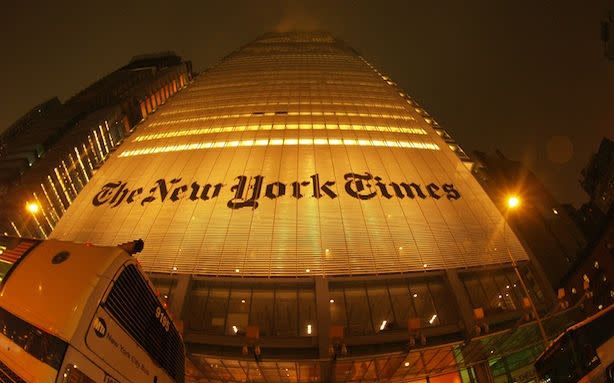The New York Times Is Getting a Cheaper Paywall Because It Has To
The business drama behind the New York Times paywall is, at its core, this: can the news organization find new subscription revenue faster than it loses advertising revenue? And, while it has pioneered the paywall, signing up 676,000 subscribers through the end of the fourth quarter, the announcement that it will offer new, cheaper tiers shows that is not enough paying customers. As its most recent earnings report show, while advertising revenues fell 11.2 percent in the first quarter while circulation revenues, including digital subscriptions, rose only 7 percent—not fast enough to keep up with the changing business model.
RELATED: Two Very Different Takes on Making 'Scream 4'
The problem, as this chart from Zach Seward a Quartz shows, seems to be that The Times may have signed up most of the people willing to pay at least $180 a year (which is currently its lowest priced digital subscriptiob) for the Times journalism they read.
RELATED: Bob Herbert Leaving The New York Times Op-Ed Page
RELATED: Couric Finally Makes It Official; Raimi Fights For Swank
That means that while digital subscriptions continues to grow, it's not on track to grow explosively from its current level around 700,000 (which, incidentally, is not too much lower than the 1 million-ish print circulation The Times had before the big, bad Internet changed everything).
RELATED: About.com Is Killing The New York Times
The solution to the problem is to expand the universe of potential subscribers, and the new lower-priced tiers in the paywalls are an attempt to do just that. The paper hasn't given exact pricing details, but in its "New Strategy for Growth" note it touted adding a "lower-priced paid product" that will offer a selection of the "most important and interesting stories" from the Times. (So, maybe top news, but not every story the paper publishes.) They will also offer other subscriptions, "also at lower price points," which will just cover certain subjects (the press release mentions, "politics, technology, opinion, the arts and food").
RELATED: Post-Pay Wall, New York Times Sees a Dip In Traffic
The Times is also creating subscriptions that cost more than its current offerings ("an enhanced tier") but those are more about getting some subset of the current 676,000 to pay more rather than expanding subscribers overall, so that's not where the big growth opportunity lies. The Times will also maintain its free offering of a metered access to set number of stories a month — currently set at ten — according to a spokesperson.
After two years of easing people into a paywall, The Times has slowly normalized the idea of paying for news. And even outside the Times, digital readers who seek out quality reporting and writing as other outlets look to mimic the success of The Times and The Wall Street Journal. The Washington Post recently announced it would experiment with a paid model, and The New Yorker, which charges for none of its digital content right now, recently emailed out a survey asking readers how they felt about different digital models, both metered and not. So while there is little question that the future of news won't be free, the bigger question is just how many paying readers are out there.


